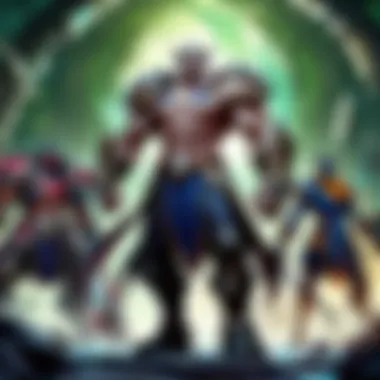Understanding League Tournaments: Structure and Strategy


Intro
League tournaments have become a pivotal element in the evolution of esports, particularly in games like League of Legends. Their structure, strategy, and significance are intricate and essential for understanding the broader community dynamics. Tournaments create a competitive hierarchy, allowing players to showcase their skills while teams compete for glory and rewards. This segment will explore the core components that comprise league tournaments, focusing on how they not only shape the competitive landscape but also influence the growth of the esports industry.
In this article, we will delve into various aspects of league tournaments, covering their structure, strategies involved, and how they contribute to the community at large. We will examine champion spotlights, gameplay tips, recent patch updates, community news, and additional content that resonates with players and fans alike.
The significance of understanding league tournaments extends beyond just gameplay; it involves grasping the nuances of competitive dynamics and how these events propel the esports ecosystem forward. To facilitate this discussion, we will structure the narrative into coherent sections that capture the essence of what drives players, teams, and the audience in this exciting arena.
By unpacking these themes, we aim to provide insight that is valuable not only for avid players but anyone intrigued by the overarching structure and importance of league tournaments in League of Legends.
Prolusion to League Tournaments
League tournaments hold a pivotal position in the landscape of competitive gaming. They provide a structured and exciting environment where players and teams can showcase their skills. Understanding these tournaments is critical for athletes, fans, and stakeholders alike. Through examining their structure, strategies, and significance, one can grasp the full extent of their impact on esports.
Definition and Importance
League tournaments are organized competitive events that often involve teams or players competing against each other in a structured format. In many cases, tournaments can dictate career paths for players, shape team reputations, and drive fan engagement. The importance lies not only in the gameplay but also in the social and economic aspects they foster. They offer opportunities for players to earn recognition, gain sponsorships, and build a professional career. Additionally, tournaments are essential for cultivating a vibrant community, as they encourage spectators to engage deeply with their favorite games.
Historical Context
The roots of league tournaments can be traced back to early gaming events in the 1970s and 1980s. However, the emergence of the internet in the late 1990s transformed these tournaments. Games like StarCraft offered a new frontier for competitive play, paving the way for the complex structures we see today. As the gaming community grew, so did the scale and frequency of these events. Titles like League of Legends exemplify this evolution, highlighting how tournaments have become significant cultural phenomena. The advent of live streaming platforms has only heightened their visibility and impact within the global gaming community. These historical changes underline the ongoing relevance of league tournaments in shaping the future of esports.
League of Legends and Its Competitive Scene
League of Legends holds a significant position in the landscape of competitive gaming. This section aims to unpack the various elements surrounding the game and its competitive scene. The focus is not just on the gameplay itself, but on the entire ecosystem that has developed around this popular title. The strategic depth of League of Legends has made it a goldmine for both players and spectators.
An Overview of League of Legends
League of Legends, developed by Riot Games, is a multiplayer online battle arena (MOBA) game that emphasizes teamwork and strategy. Players control unique champions with distinct abilities, aiming to destroy the opponent's Nexus while protecting their own. This core objective, coupled with diverse maps and character builds, creates an engaging competitive environment.
The game’s complexity requires players to master not only their individual champions but also to understand the synergy between different champions. Each match is about adapting strategies in real-time, reacting to opponents’ moves, and optimizing team composition. Such factors elevate League of Legends beyond merely a game; it represents a structured competitive discipline that requires both skill and mental acuity.
Rise of Esports in Gaming
The ascent of esports as a legitimate industry aligns closely with the growing popularity of League of Legends. Esports tournaments attract millions of viewers, and their impact on gaming culture cannot be overstated. Events like the League of Legends World Championship showcase the pinnacle of competitive play, drawing in large sponsorship deals and vast audiences.
This rise can be attributed to several factors:
- Accessibility: With the game free to play, it reaches a wider audience, allowing more players to engage.
- Community: The supportive and active community fosters participation, which in turn enhances viewer engagement through platforms like Twitch and YouTube.
- Sustained Growth: Continuous updates and new content keep the game fresh and relevant, encouraging players and spectators to return.
"As of 2023, League of Legends has a dedicated competitive scene that attracts over 100 million players globally, making it one of the leading esports titles."
Tournament Formats and Structures
The structure of a league tournament plays a significant role in determining the overall experience for teams, players, and fans. The choice of format influences how matches are organized, the duration of the tournament, and even the type of strategies teams may employ. Understanding various tournament formats allows participants to adapt their playstyle effectively. Additionally, fans and viewers gain a better grasp of what to expect, increasing their engagement.
Single Elimination
In a single-elimination format, teams compete in a knockout system, meaning that once a team loses a match, it is eliminated from the tournament. This straightforward structure is popular due to its simplicity. Every match carries high stakes, pushing players to perform at their best under pressure. This format can lead to thrilling upsets where lower-seeded teams knock out favorites.
However, the downside is that a single loss eliminates any chance for recovery. Therefore, teams must approach each game with optimal focus and preparation. It’s not uncommon to see significant strategies emerging around scoutings, such as analyzing opponents' previous performances. Teams often maximize their available resources for matchup analysis, as this can be the difference between victory and elimination.
Double Elimination
The double-elimination format provides a safety net for teams. A team is only fully out of the tournament after two losses, which allows them a chance for redemption. This format is more forgiving and often leads to more comprehensive narratives as teams have multiple opportunities to advance.


The versatility of double-elimination breeds a dynamic atmosphere. Teams may adjust strategies based on wins or losses from earlier rounds. Often, spectators see fascinating evolutions in team play, as adjustments are made mid-tournament. However, it can become lengthy, demanding greater stamina from players and possibly affecting performance in later stages. Coordination and teamwork are critical here; teams need effective communication to overcome any setbacks and strategize to capitalize on their second chances.
Round Robin
In a round robin tournament, every team plays against every other team at least once. This format is notable for its comprehensive approach, providing a balanced competition environment. The teams are ranked based on their performance across all matches, with the best typically moving forward in the tournament.
The round-robin format is beneficial for accurately measuring a team's strength. It offers a clear sense of the overall skill levels involved, as every match contributes to final standings. However, this format may be time-consuming since it requires more games than others. It can be cumbersome for larger leagues, yet it encourages fair play and provides a complete picture of a team's capabilities and potential weaknesses.
Group Stage Formats
Group stage formats combine aspects of both round robin and knockout styles. Teams are divided into smaller groups, usually four to six teams each. They play round robin matches within their group, with top teams advancing to the knockout stage. This structure creates excitement through a mix of smaller matchups and high-stakes elimination rounds.
Group stages are excellent for nurturing rivalry and fostering interaction among teams. Team dynamics can shift significantly, leading to unexpected strategies and plays based on earlier games. This format keeps audiences engaged from the start until the final knockout rounds, as early games can greatly influence subsequent matches. Furthermore, the anticipation built during group stages often leads to heightened stakes and viewer engagement as the tournament progresses.
Key Components of a Successful Tournament
Understanding the key components of a successful tournament is essential for anyone involved in the competitive gaming scene. This includes organizers, players, and sponsors. Each component plays a role that can influence the outcome and reception of the tournament. A well-structured tournament attracts more participants and enhances the viewer experience.
Organizational Structure
The organizational structure directly impacts how a tournament is planned and executed. A clear hierarchy allows for effective communication and task delegation. Key roles include tournament director, event coordinators, and marketing personnel. Each team member must understand their responsibilities to ensure smooth operations.
Moreover, having a structured team can facilitate better decision-making processes. For instance, event coordinators can quickly adapt to changes, such as scheduling conflicts or technical issues. The success of the tournament often hinges on the ability to resolve problems efficiently.
Benefits of a Strong Organizational Structure:
- Clears lines of communication
- Streamlines planning processes
- Increases responsiveness to issues
- Enhances participant satisfaction
Sponsorship and Funding
Sponsorship and funding are crucial for the sustenance and growth of league tournaments. Securing sponsors allows organizers to cover expenses related to venues, equipment, and advertising. It can also provide monetary prizes for top competitors, increasing the stakes of the tournament.
Building relationships with companies that share an interest in the space can lead to long-term partnerships. Brands like Red Bull and Intel have made significant contributions to esports events, signaling their commitment to the growth of the industry.
Considerations for Securing Sponsorship:
- Identify potential sponsors aligned with your target audience.
- Create a compelling sponsorship proposal highlighting metrics like expected viewership and demographics.
- Establish clear benefits for sponsors, such as branding opportunities at the event.
Venue and Production Quality
The venue selected for a tournament greatly affects its overall atmosphere and accessibility. A well-chosen venue not only accommodates players and staff but also provides a pleasant experience for spectators. Key aspects include seating capacity, location, and facilities.
Production quality is equally important. High-quality streaming, professional commentators, and visually appealing graphics engage viewers and enhance the online experience. Investing in advanced technology for broadcasting can lead to higher viewer retention rates during livestreams.
Together, venue selection and production quality can capture attention and drive enthusiasm.
“The right venue, combined with superior production quality, has the potential to elevate an average tournament into a memorable experience for both players and fans.”
Strategies for Competitors in League Tournaments
The realm of league tournaments is highly competitive and nuanced. For players in games like League of Legends, understanding the various strategies is crucial for achieving success. Strategies for competitors stretch beyond pure gameplay. They involve meticulous planning, coordination, and adaptation to both the players' strengths and the opponents' weaknesses. By developing effective strategies, teams can enhance their performance, mitigate risks, and build a strong foundation for achieving their tournament goals.
Team Composition and Roles
A fundamental aspect of competitiveness in League tournaments is team composition. Composition refers to the selection and balance of champions within a team. Each champion has unique abilities and roles, such as tanks, damage dealers, and support characters. Therefore, it is vital to assemble a team that boasts a mix of offense, defense, and healing capabilities. This balance ensures that the team can adapt in various situations.


Players must communicate clearly about their preferences and skill sets. Considerations for composition include:
- Champions' synergy: Certain champions work well together, enhancing each other's abilities.
- Counter-picking: Selecting champions that can effectively counter expected enemy picks.
- Flexibility: Choosing champions that can fill multiple roles helps in draft flexibility no matter the opponent's strategy.
Flexibility and synergy within the team can lead to significant advantages in matches.
Draft Strategies
Drafting is a pivotal moment before a tournament match. It's where teams select their champions. Draft strategies require foresight and planning. Teams must analyze their strengths while considering opponents'. The drafting stage can be broken down into:
- Banning opponents’ key champions: This eliminates choices that could give the enemy a competitive edge.
- Prioritizing strong picks: Teams should select champions that can dominate the match, taking into account their own strategies and strengths.
- Adaptability during drafts: Teams must read the opposing team’s intentions and adapt their choice strategy accordingly.
A good draft can establish the tone of the match, making it a crucial tactical element.
Map Control and Objectives
Control over the game's map is another vital strategy. Map control refers to the ability to influence different match areas effectively. Competitors must constantly assess opportunities to secure objectives such as towers, dragons, and Baron Nashor. These objectives provide significant advantages in matches.
To achieve effective map control, teams should focus on the following:
- Vision control: Placing wards allows teams to gather information on enemy movements and avoid dangerous situations.
- Objective prioritization: Teams must identify which objectives are most beneficial and plan their movements accordingly.
- Pressure and rotations: Communicating pressure on a certain lane can force opponents to react, opening up other opportunities on the map.
The Role of Spectators and Community Engagement
The role of spectators and community engagement is a fundamental aspect of league tournaments, shaping not only the atmosphere but also the economic and social dimensions of competitive gaming. Spectators contribute significantly to the overall experience, creating an immersive environment that enhances the viewing of intense matches. Their engagement drives the popularity of the tournaments, impacting the sponsorship potential and the future of esports.
Fan Involvement and Interaction
Fans are the heartbeat of any tournament. Their involvement goes beyond mere attendance. Many fans actively participate through online platforms, creating a dynamic feedback loop that fosters community development. They engage through social media channels like Twitter and Facebook, where they can discuss strategies, celebrate victories, and share experiences. This interaction allows fans to connect not just with the games but with one another.
Moreover, fan clubs often emerge around teams, creating a support network that can influence tournament outcomes. These clubs organize viewing parties, contribute to merchandise sales, and engage in discussions that enhance the team's visibility. Such grassroots support can boost a team’s morale, potentially impacting their performance on the battlefield.
The presence of dedicated fans at physical venues also provides essential energy. Loud cheers, held breath, and collective reactions amplify the drama of the tournaments. This palpable enthusiasm contributes to the overall viewing experience, making the games more exciting for players and spectators alike.
Content Creation and Streaming
In today’s digital age, content creation and streaming have revolutionized how tournaments are consumed. Platforms like Twitch and YouTube allow fans to not only watch but also create content related to the tournaments. Streamers provide commentary, analyses, and engaging narratives that enrich the viewing experience. Fans can watch live matches, participate in chats, and even influence gameplay through suggestions during streams. This interactivity is key to maintaining viewer interest and building a dedicated community around League of Legends tournaments.
Content creators often analyze matches post-game, highlighting teams' strategies, player performances, and emerging trends. This content not only serves as entertainment but also as a learning resource for aspiring players and analysts. Consequently, the audience’s reach is expanded beyond just those who are physically present at the tournament. It also invites views from a global audience, thus diversifying the spectator base.
To conclude, the role of spectators and community engagement is paramount in shaping league tournaments within the esports ecosystem. Their active participation and content creation drive the economic viability of these events and enhance the collective culture surrounding competitive gaming.
"The community's engagement transforms a tournament from a mere gathering into a cherished experience that influences the direction of competitive gaming itself."
Engaging with fans and evolving alongside community dynamics is not just beneficial; it is essential for the sustainability and growth of league tournaments.
Impact of League Tournaments on the Gaming Industry
League tournaments play a crucial role in shaping the gaming industry, particularly within the context of competitive gaming and esports. Their structure influences not only how games are played but also how they are perceived by the public.
Economic Contributions
The financial impact of league tournaments is significant. They generate substantial revenue, benefitting not only the organizers but also the game developers, participants, sponsors, and local economies where events are hosted.
- Sponsorship and Funding: Major sponsors like Coca-Cola and Red Bull inject millions into tournaments, increasing visibility and creating marketing opportunities. This relationship often leads to long-term partnerships, boosting the economic ecosystem around esports.
- Job Creation: Competitions create jobs, ranging from management positions in organizing companies to roles in production and broadcasting. The rise in tournaments has led to numerous niche job opportunities that cater to this growing industry.
- Increased Game Sales: Tournaments often boost sales of the games featured, as the excitement generated can lead to spikes in player interest and purchases. Event popularity can therefore directly correlate with an uptick in revenue for game developers.


Cultural Significance
League tournaments have become cultural phenomena, influencing social interactions and community building. They foster an environment where fans connect and share experiences, creating a vibrant community around gaming.
- Fan Engagement: Competitive events engage fans through live tournaments, streams, and social media interactions. Fans become part of the experience, discussing strategies and celebrating victories. This involvement encourages a sense of belonging among gamers and fans.
- Crossover into Mainstream Culture: Notable tournaments have crossed over into mainstream media, showcasing gaming in a new light. Events are often broadcast on platforms like Twitch and YouTube, further blurring the lines between traditional sports and esports.
- Diversity and Inclusion: Tournaments encourage participation from diverse backgrounds, promoting inclusivity. Initiatives aimed at supporting women and underrepresented groups in gaming are growing, leading to a more extensive and enriched culture in the esports community.
Shifts in Game Design and Development
The competitive landscape created by league tournaments has influenced how games are designed and developed. This includes consideration of player engagement and long-term viability.
- Balancing Competitive Play: Developers are increasingly focusing on balance and fairness to ensure competitive integrity. This means regularly updating games based on feedback from tournament players.
- Focus on Replayability: Game design is shifting towards creating experiences that keep players engaged over long periods. Features that promote replayability are essential, ensuring tournaments remain exciting for both players and spectators.
- Enhancing Spectator Experience: Game developers are also prioritizing the spectator experience. Features like custom health bars, dynamic camera angles, and in-game statistics help create a more engaging viewing experience, vital for attracting audiences.
"The evolution of league tournaments has not just changed how games are played; it has transformed the entire industry landscape, making it imperative for developers and organizers to adapt continually."
As sensory experiences continue to evolve, the significance of league tournaments in shaping both the competitive gaming environment and the broader industry cannot be overstated. They remain central to understanding the dynamics of modern gaming.
Future Trends in League Tournaments
Understanding future trends in league tournaments is crucial for anticipating how the competitive gaming landscape will evolve. These trends highlight the ongoing transformation in technology, community dynamics, and the push for inclusivity. This section will discuss the significance of these aspects while providing insights relevant to players and industry stakeholders.
Technological Advancements
The ongoing development of technology profoundly impacts league tournaments. Innovations such as virtual reality and advanced streaming technology are reshaping how tournaments are organized and experienced. For example, virtual reality can bring a new level of immersion to the audience, making them feel like they are part of the action. Meanwhile, enhanced streaming platforms ensure that audiences can engage with content more easily than ever.
Moreover, data analytics tools are becoming more sophisticated. Teams can analyze gameplay data to improve strategies and optimize team performances. Players can exploit this tech to gain competitive advantages. Considering these factors is essential for anyone involved in competitive gaming to stay current and gain an edge.
Evolving Community Dynamics
Community involvement is shifting. The players' voice has become more influential. Organizations are now prioritizing community engagement. Whether it's through discussions on platforms like Reddit or feedback sessions, the input from players and fans shapes tournament structures and formats. This shift encourages a more interactive environment where the community feels valued.
Additionally, social media plays a vital role in fostering community dynamics. Real-time interactions on platforms like Facebook enhance the relationship between players and fans. This interaction results in a more cohesive community, generating excitement around events and ultimately boosting tournament attendance and viewership.
Inclusivity and Diversity Initiatives
Inclusivity remains a high priority in league tournaments. The focus now extends beyond gender equality to include diversity in all aspects. Organizations are recognizing that broadening participation can lead to richer tournament experiences, benefiting all players and fans alike.
Many tournaments are implementing diversity initiatives, actively encouraging participation from underrepresented groups in gaming. This effort not only reflects societal values but also enhances the competitive scene. A more diverse player pool invariably leads to more varied strategies, enriching the game itself.
"Diversity in competitive gaming enriches the experience for everyone involved, creating an environment where innovation thrives."
In summary, future trends in league tournaments highlight the importance of keeping abreast of technological advancements, fostering community dynamics, and promoting inclusivity and diversity initiatives. These elements will significantly influence the direction of competitive gaming, making it essential for participants and organizers to engage with these trends to fully realize the potential of league tournaments.
Ending
The conclusion serves a crucial role in tying together the various strands discussed throughout the article, offering a final overview of league tournaments and their multifaceted significance. In this section, we emphasize several key elements that emerge from our detailed exploration.
Summarizing Key Insights
Through our examination of league tournaments, particularly in the context of League of Legends, we find that the structure of these competitions is thoughtfully designed to enhance not just gameplay but also viewer engagement. Tournaments have evolved from informal gatherings to grand events attracting millions of spectators online and in person. The historical narrative of esports showcases pivotal moments that shaped current formats and practices.
Economic contributions of these tournaments cannot be understated. They drive revenue for game developers, teams, and sponsors alike. Community engagement remains a dynamic element, with fans taking part through streaming, content creation, and active participation in tournaments, further enriching the gaming landscape. This collaborative spirit fosters a diverse environment that both players and fans appreciate.
The Future of League Tournaments
Looking ahead, the future of league tournaments appears promising, influenced by numerous technological advancements. Tools for real-time analytics and virtual reality may redefine spectator experiences and participant training. Additionally, the ongoing evolution of community dynamics suggests that inclusivity will play an integral part in the development of these tournaments.
As the industry continues to grow, driving innovations in game design and accessibility, it will be vital to prioritize diversity and representation within competitive scenes. Overall, the combination of economic impact, cultural significance, and a commitment to inclusivity paints a comprehensive picture of where league tournaments are headed.
"The continued growth of esports requires a focus not only on competitiveness but also on community and inclusivity, ensuring a diverse future for all players and fans."
As we conclude, it is evident that league tournaments are now more than just a series of matches; they are a cornerstone of the gaming community, shaping it for generations to come.







